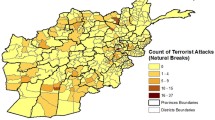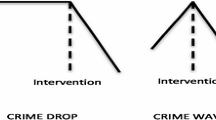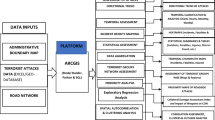Abstract
Objectives
One of the areas in terrorism that has not been adequately examined, is the geographic concentration of terror attacks in a city’s micro places. The literature related to the geographical distribution of terror generally focuses on macro places: continents, countries, and regions. In contrast, in the study of ordinary crime, significant studies have been conducted on the distribution of crime in micro-places “hot spots”. The findings of these studies have great significance when adopting models of law enforcement. This study examines whether there is a concentration of terror attacks in a limited number of hot spots that are stable over time.
Methods
This study examines the entire population of terror attacks in the city of Jerusalem between 2000 and 2017 (249 attacks involving explosives, shootings, stabbings, attacks with a deadly weapon, and run over attacks) as a case study. We investigated and mapped each attack’s exact location (for the majority of attacks) and characterized the particular micro places of these terror attacks, as well as the attacks themselves.
Results
The research revealed that there is a higher frequency of terror attacks concentrated in specific hot spots and that they are stable over time.
Conclusions
The concentration of terror attacks calls for a specialized counterterrorism response equivalent to “hot spots policing” based on the characteristics of the potential terrorist hot spots.

Similar content being viewed by others
Notes
As mentioned, “Facilitating conditions” are one of the ‘four pillars of opportunity’ necessary for a terrorist attack (Clarke and Newman 2006; Fahey et al. 2012; Perry et al. 2019). According to Eck and Madensen (2009) the opportunity component includes the convergence of physical and social circumstances in time and space to influence the attackers’ perception when deciding to carry out the attack. Since the social circumstances of Jewish terrorists are considerably different from those of Palestinians, the two cases of Jewish terrorism were excluded from the analysis.
There are Palestinian villages (for example: the Kafr Aqab area in the north, Shuafat refugee camp in the north-east, Arab al- Swachra, Um Lyson and Umm Tuba in southeast of Jerusalem) that were annexed to the city of Jerusalem after the Six-Day War. Although they are technically within the municipal jurisdiction of Jerusalem, in many respects they are not an integral part of the city of Jerusalem and therefore they were not included in the study. It is also important to note that Jewish citizens rarely enter these locations and therefore there is an absence of potential victims. The study also did not include the areas adjacent to the security checkpoints on the city’s boundaries which border the Palestinian Authority, since they are also not an integral part of the city. See: The Jerusalem Institute for Policy Research—http://en.jerusaleminstitute.org.il/.
Most of the attackers who carried out the 249 attacks were killed or arrested (and then interrogated) following their attacks. As such, their identity is known. In a few cases, the attackers were not apprehended but the investigation following the attack clearly determined that the attack was carried out by Arabs targeting Jews. Not included in this study were attacks where there was uncertainty regarding whether they involved an Arab terrorist targeting Jews.
A form of irregular warfare in which a small group of paramilitary combatants use the classic strategy of hit and run warfare while taking advantage of some form of sovereignty or control over a defined geographical area and its population (Martin 2016).
Not including those Arab villages annexed to Jerusalem (see footnote 2 page 11).
These attackers did not belong to any of the known local organizations and are therefore believed to have lacked formal infrastructure supporting the attack.
See the Israeli Security Agency (ISA) site at https://www.shabak.gov.il/publications.
This is especially noticeable at the bottleneck passages on the way and inside the Old City where many of the attacks have been carried out. The Damascus Gate for example is used for passage between the Old City and the East Jerusalem neighborhoods adjacent to it and is open for pedestrians only. Tens of thousands of Palestinians from the West Bank pass through the Damascus Gate in order to pray at the Al-Aqsa mosque. This gate is also the entrance which is used by many Jews on their way to the Western Wall and the Old City. https://he.wikipedia.org/wiki/%D7%A9%D7%A2%D7%A8_%D7%A9%D7%9B%D7%9D.
References
Bakker E, De Graaf B (2011) Preventing lone wolf terrorism: some CT approaches addressed. Perspect Terror 5:43–50
Becker M (2014) Explaining lone wolf target selection in the United States. Stud Conf Terror 37(11):959–978
Bernasco W (2014) Crime journeys: patterns of offender mobility. Oxford University Press, Oxford
Bernasco W, Steenbeek W (2017) More places than crimes: implications for evaluating the law of crime concentration at place. J Quant Criminol 33(3):451–467
Bernasco W, Nijkamp P, Poot J, Bakens J (2015) Ethnic segregation and crime: are offenders ethnically biased when choosing target areas? Econ Cult Divers. https://doi.org/10.4337/9781783476817.00015
Braga AA, Weisburd DL (2012) The effects of focused deterrence strategies on crime: a systematic review and meta-analysis of the empirical evidence. J Res Crime Delinq 49(3):323–358
Braga AA, Papachristos AV, Hureau DM (2010) The concentration and stability of gun violence at micro places in Boston, 1980–2008. J Quant Criminol 26(1):33–53
Braga AA, Hureau AM, Papachristos AV (2011) The relevance of micro places to citywide robbery trends: a longitudinal analysis of robbery incidents at street corners and block faces in Boston. J Res Crime Delinq 48(1):7–32
Braga AA, Andresen MA, Lawton B (2017) The law of crime concentration at places: editors’ introduction. J Quant Criminol 33:421–426
Braithwaite A, Li Q (2007) Transnational terrorism hot spots: identification and impact evaluation. Confl Manag Peace Sci 24(4):281–296
Brantingham P (2011) Crime and place: rapidly evolving research methods in the 21st century. Cityscape 13:199–203
Brantingham PL, Brantingham PJ (1993) Nodes, paths and edges: considerations on the complexity of crime and the physical environment. J Environ Psychol 13(1):3–28
Brantingham P, Brantingham P (1995) Criminality of place. Eur J Crim Policy Res 3(3):5–26
Brantingham PL, Brantingham PJ (1999) A theoretical model of crime hot spot generation. Stud Crime Crime Prev 8(1):7–26
Brantingham PJ, Brantingham PL (2003) Anticipating the displacement of crime using the principles of environmental criminology. Crime Prev Stud 16:119–148
Clarke RV (1997) Introduction. Situational crime prevention: successful case studies. Harrow and Heston, Guilderland
Clarke RV, Cornish DB (1985) Modeling offenders’ decisions: a framework for research and policy. Crime Justice 6:147–185
Clarke R, Newman G (2006) Outsmarting the terrorists. Praeger Security International, Westport
Cornish DB, Clarke RV (1987) Understanding crime displacement: an application of rational choice theory. Criminology 25(4):933–948
Curiel RP, Bishop S (2016) A measure of the concentration of rare events. Sci Rep 6:32369
Curiel RP, Delmar SC, Bishop SR (2018) Measuring the distribution of crime and its concentration. J Quant Criminol 34(3):775–803
De Moor S, Vandeviver C, Vander Beken T (2018) Are DNA data a valid source to study the spatial behavior of unknown offenders? Sci Justice 58:315–322
Dugan Laura, LaFree Gary, Piquero Alex R (2005) Testing a rational choice model of airline hijackings. Criminology 43(4):1031–1066
Eck JE, Madensen TD (2009) Using signatures of opportunity structures to examine mechanisms in crime prevention evaluations. In: Knutsson J, Tilley N (eds) Evaluating crime reduction initiatives. Criminal Justice Press, Monsey, pp 59–85
Eck JE, Lee Y, SooHyun O, Martinez NN (2017) Compared to what? Estimating the relative concentration of crime at places using systematic and other reviews. Crime Sci 6:8. https://doi.org/10.1186/s40163-017-0070-4
Fahey S, LaFree G, Dugan L, Piquero AR (2012) A situational model for distinguishing terrorist and non-terrorist aerial hijackings, 1948–2007. Justice Q 29(4):573–595
Farrell G, Pease K (eds) (2001) Repeat victimization. Crime prevention studies, vol 12. Lynne Reinner, San Diego
Favarin S (2018) This must be the place (to commit a crime). Testing the law of crime concentration in Milan, Italy. Eur J Criminol. https://doi.org/10.1177/1477370818757700
Felson M (2017) Linking criminal choices, routine activities, informal control, and criminal outcomes. In: Cornish DB, Clarke RV (eds) The reasoning criminal. Routledge, London, pp 119–128
Felson M, Clarke RV (1998) Opportunity makes the thief: practical theory for crime prevention. Home Office Police Research Series No. 98
Freilich CD (2017) Israel’s counter-terrorism policy: how effective? Terror Polit Violence 29(2):359–376
Freilich JD, Chermak SM (2009) Preventing deadly encounters between law enforcement and American far-rightists. Crime Prev Stud 25:141–172
Gill P (2015) Lone-actor terrorists: a behavioral analysis. Terrorism online: politics, law and technology, vol 35. Routledge, Abingdon
Gill P, Corner E (2016) Lone-actor terrorist target choice. Behav Sci Law 34(5):693–705
Gill P, Horgan J, Deckert P (2014) Bombing alone: tracing the motivations and the antecedent behaviors of lone-actor terrorists. J Forensic Sci 59:425–435
Gill P, Horgan J, Corner E, Silver J (2016) Indicators of lone actor violent events: the problems of low base rates and long observational periods. J Threat Assess Manag 3(3–4):165
Gill P, Horgan J, Corner E (2017) The rational foraging terrorist: analyzing the distances travelled to commit terrorist violence. Terror Polit Violence 1:2. https://doi.org/10.1080/09546553.2017.1297707
Griffiths G, Johnson SD, Chetty K (2017) UK-based terrorists’ antecedent behavior: a spatial and temporal analysis. Appl Geogr 86:274–282
Groff E, McEwen T, Institute for Law and Justice, United States of America (2006) Exploring the spatial configuration of places related to homicide events. Final report
Groff ER, Weisburd D, Yang S (2010) Is it important to examine crime trends at a local “micro” level?: a longitudinal analysis of street to street variability in crime trajectories. J Quant Criminol 26(1):7–32
Groff ER, Taylor RB, Elesh DB (2014) Permeability across a metropolitan area: conceptualizing and operationalizing a macrolevel crime pattern theory. Environ Plan 46:129–152
Gruenewald J, Chermak S, Freilich JD (2013) Distinguishing ‘loner’ attacks from other domestic extremist violence. Criminol Public Policy 12(1):65–91
Hardyns W, Snaphaan T, Pauwels LJ (2018) Crime concentrations and micro places: an empirical test of the “law of crime concentration at places” in Belgium. Aust N Z J Criminol. https://doi.org/10.1177/0004865818807243
Hsu HY, Apel R (2015) A situational model of displacement and diffusion following the introduction of airport metal detectors. Terror Polit Violence 27(1):29–52
Kennedy LW (2010) Applying crime theory to terrorism research. In: Frost NA, Freilich JD, Todd RC (eds) Contemporary issues in criminal justice policy. Wadsworth Cengage Learning, Belmont, pp 129–131
Kliot N, Charney I (2006) The geography of suicide terrorism in Israel. GeoJournal 66(4):353–373
LaFree G, Morris N, Dugan L, Fahey S (2006) Identifying global terrorist hot spots. In: Victoroff J (ed) Tangled roots: social and psychological factors in the genesis of terrorism. IOS Press, Amsterdam
LaFree G, Miller E, Yang SM (2013) Terrorism in Indonesia, the Philippines and Thailand, 1970 To 2008. Secur Peace 9(2):77–86
Lee Y (2017) Comparing measures of the concentration of crime at places and times. Doctoral dissertation, University of Cincinnati
Lee Y, Eck JE, SooHyun O, Martinez NN (2017) How concentrated is crime at places? A systematic review from 1970 to 2015. Crime Sci 1:2. https://doi.org/10.1186/s40163-017-0069-x
Lum C, Kennedy LW, Sherley A (2006) Are counter-terrorism strategies effective? The results of the Campbell systematic review on counter-terrorism evaluation research. J Exp Criminol 2(4):489–516
Martin G (2016) Understanding terrorism challenges, perspectives and issues, 5th edn. Sage, Los Angeles
McCutcheon JC, Weaver GS, Huff-Corzine L, Corzine J, Burraston B (2016) Highway robbery: testing the impact of interstate highways on robbery. Justice Q 33(7):1292–1310
Mesev V, Shirlow P, Downs J (2009) The geography of conflict and death in Belfast, Northern Ireland. Ann Assoc Am Geogr 99(5):893–903
Newman GR, Hsu HY (2012) Rational choice and terrorist target selection. In: Kumar U, Mandal K (eds) Countering terrorism: psychosocial strategies. Sage Publications India, New Delhi, pp 227–250
Perry S (2014) Strategies of policing terrorism. In: Bruinsma G, Weisburd D (eds) Encyclopedia of criminology and criminal justice. Springer, New York, pp 5063–5075
Perry S, Hasisi B (2015) Rational choice rewards and the jihadist suicide bomber. Terror Polit Violence 27(1):53–80
Perry S, Jonathan-Zamir T (2014) Lessons from empirical research on policing in Israel: policing terrorism and police-community relationships. Police Pract Res Int J 15(2):173–187
Perry S, Weisburd D, Hasisi B (2016) The ten commandments for effective counterterrorism. In: LaFree G, Freilich JD (eds) Handbook of the criminology of terrorism. Wiley Press, West Sussex, pp 482–494
Perry S, Apel R, Newman GR, Clarke RV (2017) The situational prevention of terrorism: an evaluation of the Israeli West Bank barrier. J Quant Criminol 33(4):727–751
Perry S, Hasisi B, Perry G (2019) Lone terrorists—a study of run-over attacks in Israel. Eur J Criminol 16(1):102–123
Pierce GL, Spaar S, Briggs LR (1988) The character of police work: strategic and tactical implications. Northeastern University, Center for Applied Social Research, Boston
Rattner A, Portnov BA (2007) Distance decay function in criminal behavior: a case of Israel. Ann Reg Sci 41(3):673–688
Roncek DW (2000) Schools and crime. In: Goldsmith V, McGuire PG, Mollenkopf JH, Ross TA (eds) Analyzing crime patterns: frontiers of practice. Sage, Thousand Oaks, pp 153–165
Rossmo DK, Harries K (2011) The geospatial structure of terrorist cells. Justice Q 28(2):221–248
Schnell C, Braga AA, Piza EL (2017) The influence of community areas, neighborhood clusters, and street segments on the spatial variability of violent crime in Chicago. J Quant Criminol 33(3):469–496
Sherman LW, Gartin PR, Buerger ME (1989) Hot spots of predatory crime: routine activities and the criminology of place. Criminology 27(1):27–56
Silke A (1998) Cheshire-cat logic: the recurring theme of terrorist abnormality in psychological research. Psychol Crime Law 4(1):51–69
Silke A (2003) Becoming a terrorist. Terror Vict Soc Psychol Perspect Terror Conseq 29:53
Song J, Andresen MA, Brantingham PL, Spicer V (2017) Crime on the edges: patterns of crime and land use change. Cartogr Geogr Inf Sci 44(1):51–61. https://doi.org/10.1080/15230406.2015.1089188
Spaaij R (2010) The enigma of lone wolf terrorism: an assessment. Stud Conf Terror 33(9):854–870
Spaaij R (2012) Understanding Lone Wolf terrorism: global patterns, motivations and prevention. Springer, London
Spaaij R, Hamm MS (2015) Key issues and research agendas in lone wolf terrorism. Stud Conf Terror 38(3):167–178
Steenbeek W, Weisburd D (2016) Where the action is in crime? An examination of variability of crime across different spatial units in The Hague, 2001–2009. J Quant Criminol 32(3):449–469
Tita G, Griffiths E (2005) Traveling to violence: the case for a mobility-based spatial typology of homicide. J Res Crime Delinq 42(3):275–308
Vandeviver C, Steenbeek W (2017) The (in) stability of residential burglary patterns on street segments: the case of Antwerp, Belgium 2005–2016. J Quant Criminol 35:1–23
Victoroff J (2005) The mind of the terrorist: a review and critique of psychological approaches. J Confl Resolut 49(1):3–42
Weisburd D (2015) The law of crime concentration and the criminology of place. Criminology 53(2):133–157
Weisburd D, Amram S (2014) The law of concentrations of crime at place: the case of Tel Aviv—Jaffa. Police Pract Res 15(2):101–114
Weisburd D, Telep C (2012) Spatial displacement and diffusion of crime control benefits revisited: new evidence on why crime doesn’t just move around the corner. In: Tilley N, Farrell G (eds) The reasoning criminologist: essays in honour of Ronald V. Clarke. Routledge Press, New York, pp 142–159
Weisburd D, Jonathan T, Perry S (2009) The Israeli model for policing terrorism: goals, strategies, and open questions. Crim Justice Behav 36(12):1259–1278
Weisburd D, Groff ER, Yang S (2012) The criminology of place: street segments and our understanding of the crime problem. Oxford University Press, Oxford
Yang SM, Jen I (2017) An evaluation of displacement and diffusion effects on eco-terrorist activities after police interventions. J Quant Criminol. https://doi.org/10.1007/s10940-017-9367-4
Author information
Authors and Affiliations
Corresponding author
Additional information
Publisher's Note
Springer Nature remains neutral with regard to jurisdictional claims in published maps and institutional affiliations.
Rights and permissions
About this article
Cite this article
Perry, S. The Application of the “Law of Crime Concentration” to Terrorism: The Jerusalem Case Study. J Quant Criminol 36, 583–605 (2020). https://doi.org/10.1007/s10940-019-09411-2
Published:
Issue Date:
DOI: https://doi.org/10.1007/s10940-019-09411-2






